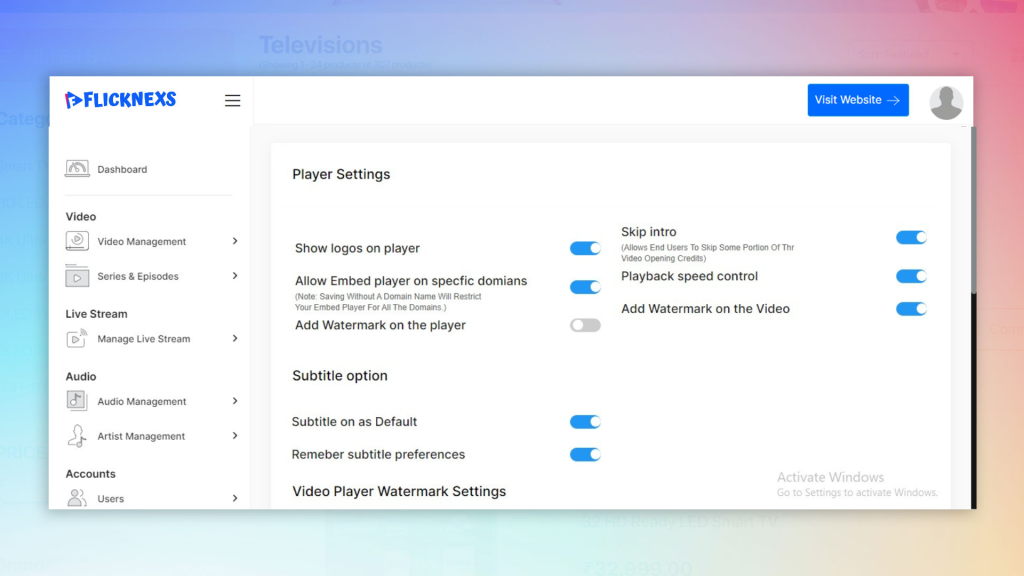Online video platforms have transformed how audiences across the globe—and especially in growing markets like India—consume video content. With over 3.5 billion internet users now streaming video, platforms offering movies, TV shows, live events, and on-demand content have become the go-to choice for entertainment.
As of 2025, the global online video platform market is valued at over $70 billion, with projections to exceed $135 billion by 2028, fueled by increased smartphone usage and affordable data.
From SVOD and AVOD to hybrid models, each online video platform now tailors its content, language, and pricing to regional preferences—making streaming more personalized than ever.
In this article, we’ll explore the different types of online video platforms and how they’ve evolved to serve diverse audiences across geographies, content needs, and monetization models.
Definition of Online Video Streaming Platforms
Online video streaming platforms refer to websites and apps that allow users to stream video content over the internet. These platforms offer a variety of content, including movies, TV shows, documentaries, live events, and more.
Users can watch their favorite content on-demand, anytime, anywhere, as long as they have an internet connection and a device to stream on.
Evolution of Video Streaming Technology
The technology behind video streaming has advanced significantly since it was first introduced. The first online video streaming platform was created in 1995 by RealNetworks, which allowed users to stream audio and video over the internet.
However, it was not until the early 2000s that online video streaming became popular, with the launch of YouTube in 2005. YouTube revolutionized the way people consume and share video content, and paved the way for other online video streaming platform.
Since then, video streaming technology has continued to evolve, with improvements in video quality, streaming speeds, and user experience. Today, online video streaming is a multi-billion-dollar industry, with millions of users worldwide.
Popularity and Growth of Online Video Streaming Platforms
The popularity of online video streaming platform can be attributed to several factors, including convenience, affordability, and variety. With online video streaming, users can watch their favorite content anytime, anywhere, without the need for a cable subscription or physical media.
Additionally, online video streaming platform offer a variety of content, including movies, TV shows, live events, and more.
The growth of online video streaming platform has been staggering, with millions of users worldwide. In 2020, the global video streaming market was valued at $50.11 billion, and is projected to grow at a CAGR of 21.0% from 2021 to 2028.
What Are the Different Types of Online Video Platforms?
There are three main types of online video streaming platforms: Subscription-based video-on-demand (SVOD) platforms, Ad-supported video-on-demand (AVOD) platforms, and Live TV streaming platforms. Now, let’s examine each of these categories more closely.
Subscription-based Video-on-Demand (SVOD) Platforms
Subscription-based video-on-demand (SVOD) platforms are the most popular type of online video streaming platform. These platforms require users to pay a monthly or annual subscription fee to access their content. SVOD platforms offer a wide variety of content, including movies, TV shows, documentaries, and more.
Some of the most popular SVOD platforms include Flicknexs, Webnexs and Hulu. These platforms offer original content, as well as licensed content from other studios and networks.
Ad-supported Video-on-Demand (AVOD) Platforms
Ad-supported video-on-demand (AVOD) platforms are another type of online video streaming platform. These platforms offer free access to their content, but users have to watch ads in between. AVOD platforms generate revenue through advertising, rather than through subscription fees.
Some popular AVOD platforms include Flicknexs, Webnexs and Tubi. These platforms offer a wide variety of content, including movies, TV shows, and live events.
Live TV Streaming Platforms (Continued)
Live TV streaming platforms offer a variety of channels, including news, sports, and entertainment. These platforms also offer features such as DVR recording, pause and rewind, and on-demand content.
Some of the most popular live TV streaming platforms include Flicknexs, Webnexs, Sling TV and fuboTV. These platforms offer different packages and channel lineups, catering to different user preferences.
Hybrid Platforms
Hybrid platforms are online video streaming platforms that offer a combination of SVOD, AVOD, and live TV streaming. These platforms offer a one-stop shop for all types of video content, catering to a wide variety of user preferences.
Some popular hybrid platforms to embed your content include Peacock, and Paramount+. These platforms offer a combination of original content, licensed content, and live TV channels.
Which Are the Top Online Video Platforms in 2025?
Sling TV
Sling TV is an online video streaming service that offers a range of channels and packages to suit your needs. There are two primary packages available: Sling Orange and Sling Blue. Sling Orange offers 30 channels, including ESPN, Disney, and AMC, while Sling Blue offers 45 channels, including Fox, NBC, and FX.
Both packages cost $35 per month, and you can also combine them for $50 per month. Sling TV also offers additional packages such as Sports Extra, News Extra, and Kids Extra.
Peacock
Peacock is a new streaming service that launched in 2020. It is owned by NBCUniversal and offers a range of TV shows, movies, and live events. The Peacock streaming service offers three different subscription tiers to cater to the varying needs and preferences of its users.
The free tier offers a limited selection of content, while the Premium and Premium Plus tiers offer more content and no advertisements. The Premium tier costs $4.99 per month, while the Premium Plus tier costs $9.99 per month.
Paramount+
Paramount+ is an online video streaming service that was previously known as CBS All Access. It offers a wide selection of TV shows and movies from the CBS network, as well as original content and live events. Paramount+ has two main packages: the Limited Commercials plan, which costs $5.99 per month, and the Commercial Free plan, which costs $9.99 per month. Both plans include a 7-day free trial
How Does an Online Video Platform Work?
Online video streaming platforms rely on streaming technology to deliver content to users. When a user clicks on a video, the platform sends a request to a content delivery network (CDN), which then sends the video to the user’s device.
Streaming requires a certain amount of bandwidth, depending on the quality of the video and the speed of the internet connection. To ensure smooth playback, it is recommended to have a high-speed internet connection and a stable network connection.
Benefits of Online Video Streaming Platforms
Online video streaming platforms offer several benefits to users, including:
Convenience and flexibility
Online video streaming platforms offer users the ability to watch their favorite movies and TV shows at their own convenience, without having to adhere to a schedule. Users can also access content from anywhere with an internet connection, making it easy to watch on-the-go.
Affordable pricing
Online video streaming platforms offer a variety of pricing options, catering to different budgets. Users can choose from free AVOD platforms or subscription-based SVOD platforms, depending on their preferences and needs.
Wide range of content options
Online video streaming platforms offer a wide range of content options, including movies, TV shows, documentaries, and original programming. Users can choose from a variety of genres and themes, ensuring there is something for everyone.
No ads (on some platforms)
Some online video streaming platforms offer ad-free viewing, eliminating interruptions during playback. This is a major benefit for users who prefer an uninterrupted viewing experience.
High-quality streaming
Online video streaming platforms offer high-quality streaming, providing users with a smooth and seamless playback experience. With advancements in streaming technology, users can enjoy high-definition and even 4K content on some platforms.
What Challenges Do Online Video Streaming Platforms Face?
While online video streaming platforms have grown in popularity, they are not without their challenges. Here are some common challenges faced by these platforms:
Internet connectivity issues
Streaming requires a fast and stable internet connection. Slow or inconsistent internet speeds can lead to buffering, poor video quality, and other issues that can negatively impact the viewing experience.
Subscription fatigue
With so many platforms available, consumers may find it overwhelming to choose which ones to subscribe to, leading to subscription fatigue. This can result in consumers choosing to cancel subscriptions or avoid signing up for new ones altogether.
Content licensing and distribution agreements
Streaming platforms need to obtain licensing agreements with content owners in order to offer their content to viewers. Negotiating these agreements can be a lengthy and expensive process, which can limit the availability of certain content.
Content piracy
Piracy remains a persistent issue for online video streaming platforms, with some users finding ways to illegally download or share content. This can lead to lost revenue for platforms and content creators.
How Do You Choose the Right Online Video Platform for Your Needs?
With so many platforms to choose from, it can be difficult to determine which one is right for you. Below are some helpful suggestions to assist you in making an informed decision:
Determine your budget and content preferences
Consider how much you are willing to spend and what type of content you want to watch. This can help you narrow down your options and choose a platform that fits your needs.
Check device compatibility
Make sure the platform you choose is compatible with the devices you plan to use to watch content, such as your TV, smartphone, or tablet.
Look for free trials and discounts
Many platforms offer free trials or discounts for new subscribers. Take advantage of these offers to test out different platforms before committing to a subscription
Read reviews and ratings
Check out reviews and ratings from other users to get a sense of the quality of the platform and its content.
Consider bundle packages and add-ons
Some platforms offer bundle packages that include access to multiple services, or add-ons that provide additional features or content. These options can provide added value and save you money in the long run.
How to Use Online Video Streaming Platforms
Online video streaming platforms have become a popular source of entertainment for people around the world. Here are some simple steps to follow when using these platforms:
Sign up and create an account
To start using an online video streaming platform, you need to sign up and create an account. Typically, this procedure requires you to provide your email address and create a password.

Choose a subscription plan
Once you have created an account, you will be prompted to select a subscription plan. Different platforms offer different subscription plans, so you will need to choose one that fits your budget and content preferences.

Browse and search for content
Once you have chosen a subscription plan, you can start browsing and searching for content to watch. Most platforms have a vast library of movies, TV shows, documentaries, and other types of content that you can choose from.

Customize settings and preferences
Online video streaming platforms allow you to customize various settings and preferences to enhance your viewing experience. For example, you can adjust the video quality, turn on subtitles, or set up parental controls.

Troubleshoot common issues
If you encounter any issues while using an online video streaming platform, you can usually find troubleshooting guides and FAQs on their website. Common issues include slow buffering, login problems, and playback errors.
Video streaming platform services:
1.Netflix
2.Amazon Prime Video
3.Hulu
4.Disney+
Conclusion
Online video streaming platforms have revolutionized the way we watch and consume entertainment. With their wide range of content options, affordable pricing, and high-quality streaming, these platforms have become a popular source of entertainment for people around the world.
In this article, we have discussed the evolution of video streaming technology, the types of online video streaming platforms, the top online video streaming platform, how they work, their benefits, challenges, and tips for choosing the right platform. We have also provided simple steps to follow when using these platforms.
As online video streaming platforms continue to evolve and grow, it is essential to stay informed about their features, pricing, and content options. By following the tips and guidelines outlined in this article, you can choose the right platform for your needs and make the most out of your streaming experience.



Leave a Reply